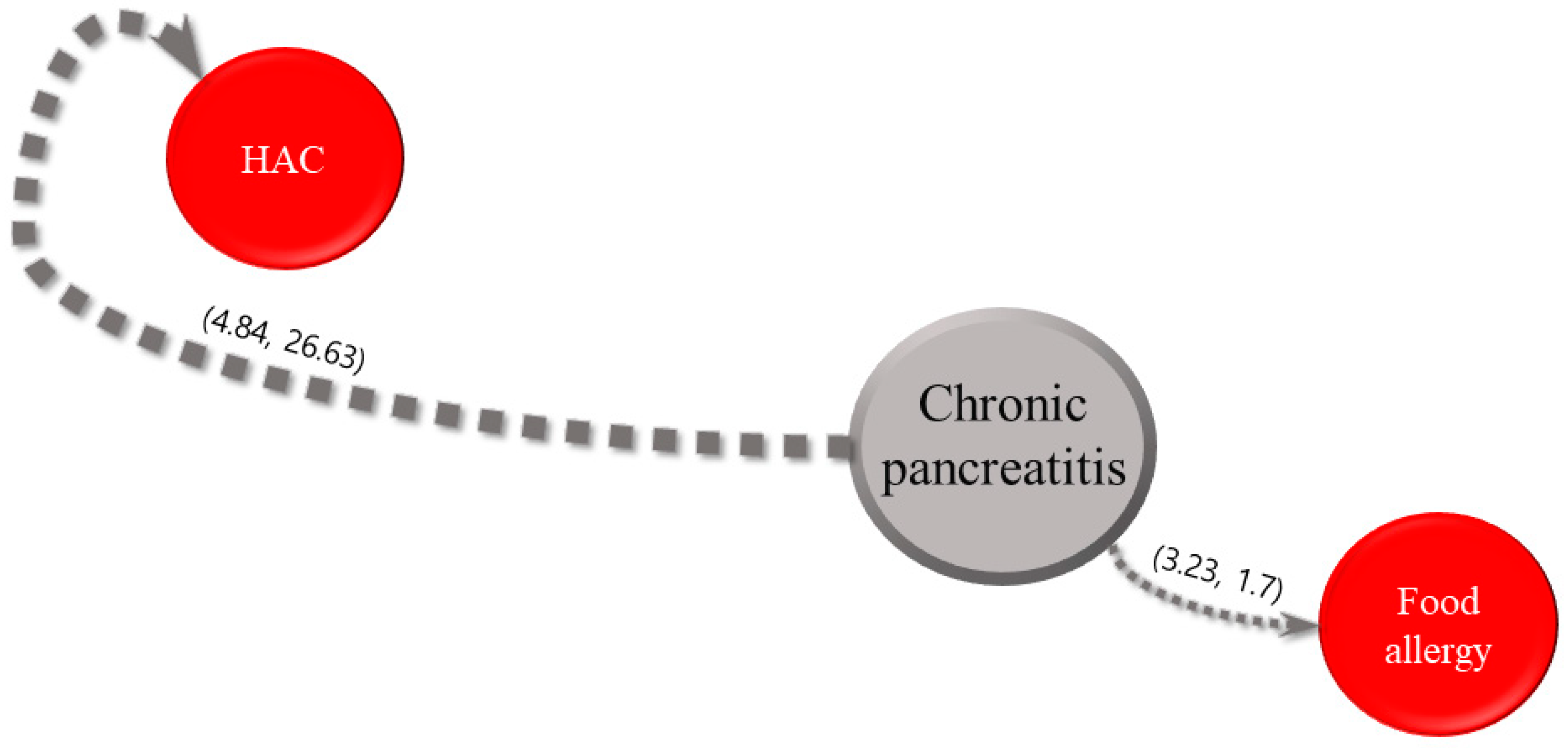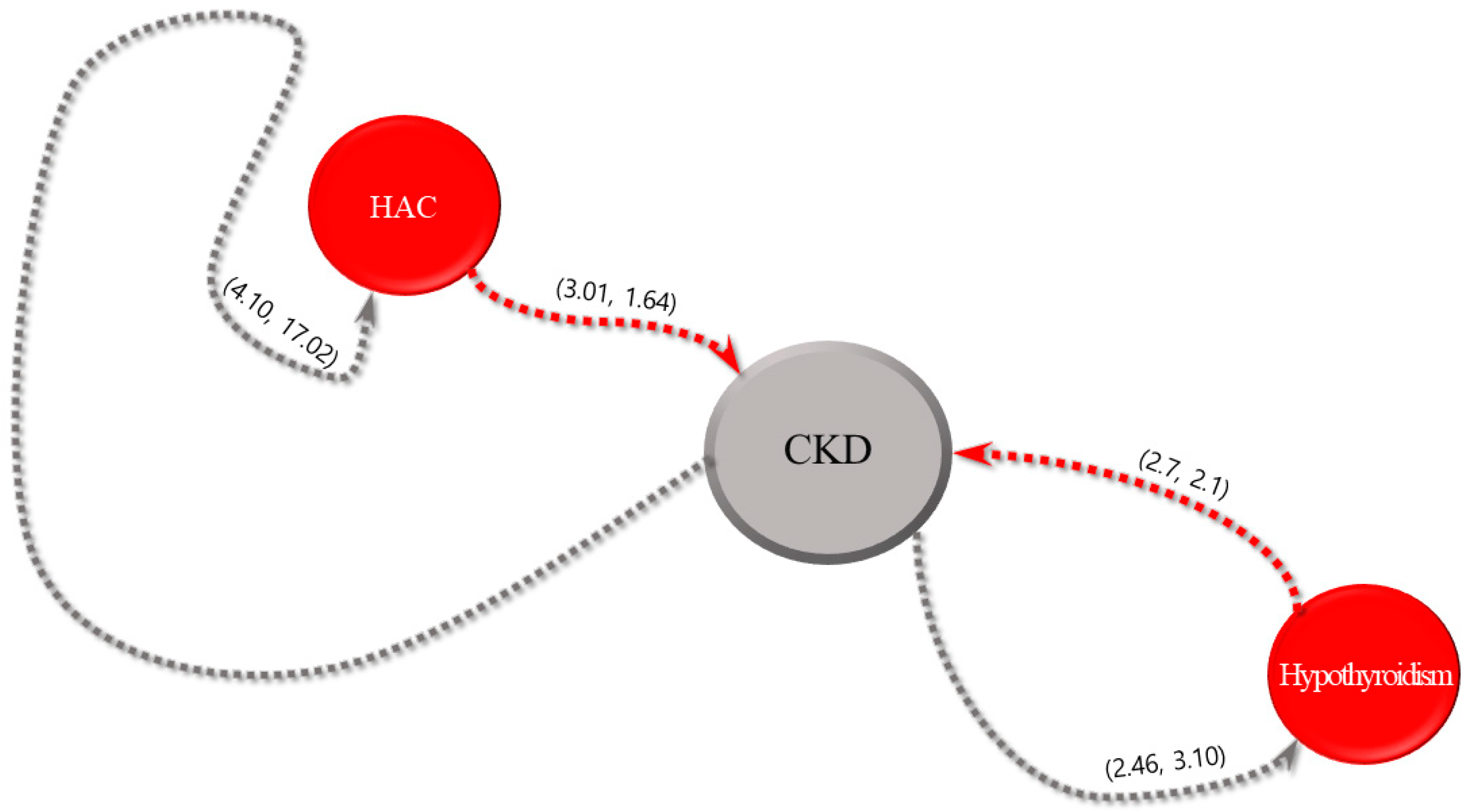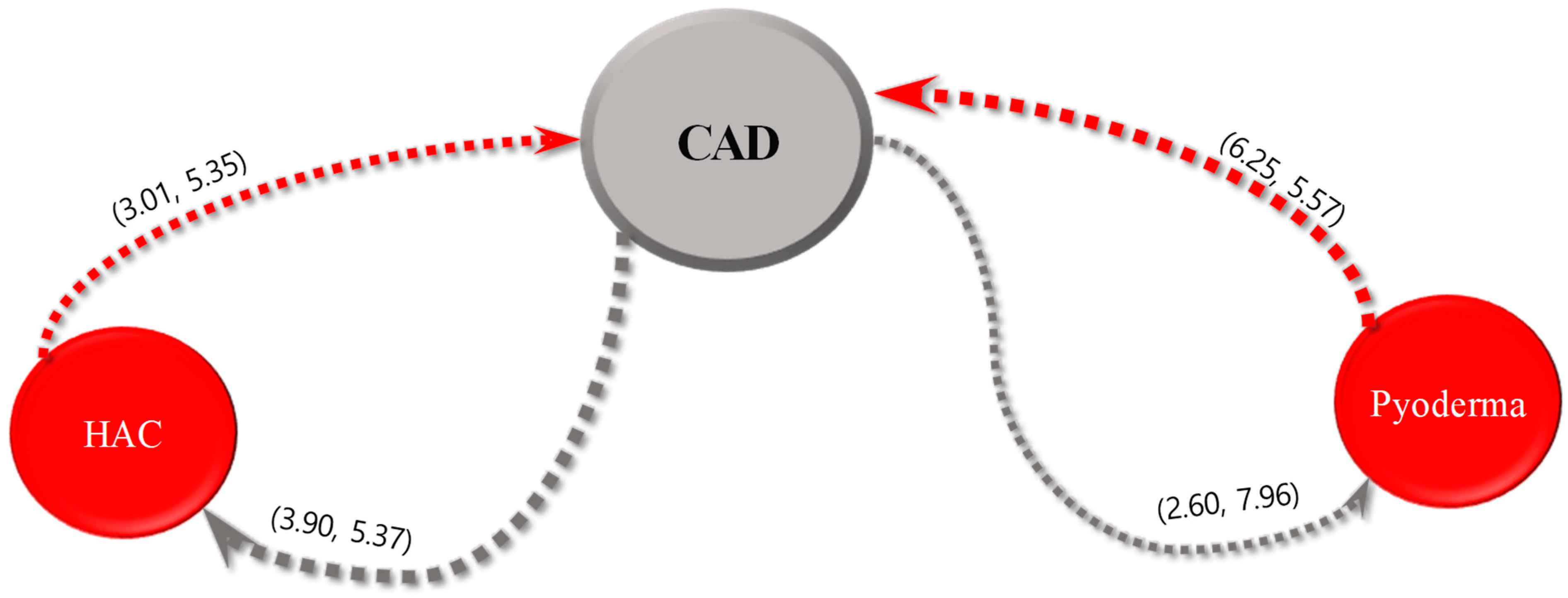Applying Sequential Pattern Mining to Investigate the Temporal Relationships between Commonly Occurring Internal Medicine Diseases and Intervals for the Risk of Concurrent Disease in Canine Patients
Abstract
:Simple Summary
Abstract
1. Introduction
2. Materials and Methods
2.1. Canine Patients
2.2. Identification of Internal Medicine Diseases
2.3. SPM
2.4. Statistical Analysis
3. Results
3.1. Canine Patient Population
3.2. Comorbidity Association Rules and Intervals for Internal Medicine Diseases
3.2.1. Hyperadrenocorticism
3.2.2. Myxomatous Mitral Valve Disease
3.2.3. Chronic Pancreatitis
3.2.4. Chronic Kidney Disease
3.2.5. CAD
3.3. Risk of Progression of the Five Most Common Veterinary Internal Medicine Diseases
4. Discussion
5. Conclusions
Author Contributions
Funding
Institutional Review Board Statement
Informed Consent Statement
Data Availability Statement
Conflicts of Interest
References
- Wright, A.P.; Wright, A.T.; McCoy, A.B.; Sittig, D.F. The use of sequential pattern mining to predict next prescribed medications. J. Biomed. Inform. 2015, 53, 73–80. [Google Scholar] [CrossRef] [PubMed]
- Prather, J.C.; Lobach, D.F.; Goodwin, L.K.; Hales, J.W.; Hage, M.L.; Hammond, W.E. Medical Data Mining: Knowledge Discovery in a Clinical Data Warehouse. Proc. AMIA Annu. Fall Symp. 1997, 4, 101–105. [Google Scholar]
- Nguyen, H.S.; Ho, D.K.N.; Nguyen, N.N.; Tran, H.M.; Tam, K.W.; Le, N.Q.K. Predicting EGFR Mutation Status in Non–Small Cell Lung Cancer Using Artificial Intelligence: A Systematic Review and Meta-Analysis. Acad. Radiol. 2023. [Google Scholar] [CrossRef] [PubMed]
- Kha, Q.H.; Le, V.H.; Hung, T.N.K.; Nguyen, N.T.K.; Le, N.Q.K. Development and Validation of an Explainable Machine Learning-Based Prediction Model for Drug–Food Interactions from Chemical Structures. Sensors 2023, 23, 3962. [Google Scholar] [CrossRef] [PubMed]
- Harms, S.K.; Deogun, J.S. Sequential association rule mining with time lags. J. Intell. Inf. Syst. 2004, 22, 7–22. [Google Scholar] [CrossRef]
- Tai, Y.M.; Chiu, H.W. Comorbidity study of ADHD: Applying association rule mining (ARM) to National Health Insurance Database of Taiwan. Int. J. Med. Inform. 2009, 78, e75–e83. [Google Scholar] [CrossRef] [PubMed]
- Agrawal, R.; Srikant, R. Mining Sequential Patterns. In Proceedings of the Eleventh International Conference on Data Engineering, Taipei, Taiwan, 6–10 March 1995; IEEE Publications: Piscataway, NJ, USA, 1995; pp. 3–14. [Google Scholar]
- Srikant, R.; Agrawal, R. Mining Sequential Patterns: Generalizations and Performance Improvements; Springer: Berlin/Heidelberg, Germany, 1996. [Google Scholar]
- Reps, J.; Garibaldi, J.M.; Aickelin, U.; Soria, D.; Gibson, J.E.; Hubbard, R.B. Discovering Sequential Patterns in a UK General Practice Database. In Proceedings of the 2012 IEEE-EMBS International Conference on Biomedical and Health Informatics, Hong Kong, China, 5–7 January 2012; IEEE Publications: Piscataway, NJ, USA, 2012; Volume 960–963. [Google Scholar]
- Batal, I.; Valizadegan, H.; Cooper, G.F.; Hauskrecht, M. A Pattern Mining Approach for Classifying Multivariate Temporal Data. In Proceedings of the 2011 IEEE International Conference on Bioinformatics and Biomedicine, Atlanta, GA, USA, 12–15 November 2011; IEEE Publications: Piscataway, NJ, USA, 2011; pp. 358–365. [Google Scholar]
- Wu, Y.S.; Taniar, D.; Adhinugraha, K.; Wang, C.H.; Pai, T.W. Progression to myocardial infarction short-term death based on interval sequential pattern mining. BMC Cardiovasc. Disord. 2023, 23, 394. [Google Scholar] [CrossRef]
- Pinaire, J.; Chabert, E.; Azé, J.; Bringay, S.; Landais, P. Sequential Pattern Mining to Predict Medical In-Hospital Mortality from Administrative Data: Application to Acute Coronary Syndrome. J. Healthc. Eng. 2021, 2021, 5531807. [Google Scholar] [CrossRef]
- McAullay, D.; Williams, G.; Chen, J.; Jin, H.; He, H.; Sparks, R.; Kelman, C. A Delivery Framework for Health Data Mining and Analytics. In Proceedings of the Twenty-Eighth Australasian Conference on Computer Science, Newcastle, Australia, 1 January 2005; Australian Computer Society, Inc.: Sydney, Australia, 2005. [Google Scholar]
- Ou-Yang, C.; Wulandari, C.P.; Hariadi, R.A.R.; Wang, H.C.; Chen, C. Applying sequential pattern mining to investigate cerebrovascular health outpatients’ re-visit patterns. PeerJ 2018, 6, e5183. [Google Scholar] [CrossRef]
- Norén, G.N.; Bate, A.; Hopstadius, J.; Star, K.; Edwards, I.R. Temporal Pattern Discovery for Trends and Transient Effects: Its Application to Patient Records. In Proceedings of the 14th ACM SIGKDD International Conference on Knowledge Discovery and Data Mining, Las Vegas, NV, USA, 24–27 August 2008; Association for Computing Machinery: New York, NY, USA, 2008. [Google Scholar]
- Jin, H.W.; Chen, J.; He, H.; Williams, G.J.; Kelman, C.; O’Keefe, C.M. Mining unexpected temporal associations: Applications in detecting adverse drug reactions. IEEE Trans. Inf. Technol. Biomed. 2008, 12, 488–500. [Google Scholar] [CrossRef]
- Bang, C.H.; Yoon, J.W.; Lee, H.J.; Lee, J.Y.; Park, Y.M.; Lee, S.J.; Lee, J.H. Evaluation of relationships between onychomycosis and vascular diseases using sequential pattern mining. Sci. Rep. 2018, 8, 17840. [Google Scholar] [CrossRef] [PubMed]
- Han, J.H.; Yoon, J.W.; Yook, H.J.; Bang, C.H.; Chun, J.H.; Lee, J.Y.; Park, Y.M.; Lee, S.J.; Lee, J.H. Evaluation of Atopic Dermatitis and Cutaneous Infectious Disorders Using Sequential Pattern Mining: A Nationwide Population-Based Cohort Study. J. Clin. Med. 2022, 11, 3422. [Google Scholar] [CrossRef] [PubMed]
- Lee, E.W.; Xiong, L.; Hertzberg, V.S.; Simpson, R.L.; Ho, J.C. Privacy-Preserving Sequential Pattern Mining in Distributed EHRs for Predicting Cardiovascular Disease. AMIA Jt. Summits. Transl. Sci. Proc. 2021, 17, 384–393. [Google Scholar]
- Chi, E.A.; Chi, G.; Tsui, C.T.; Jiang, Y.; Jarr, K.; Kulkarni, C.V.; Zhang, M.; Long, J.; Ng, A.Y.; Rajpurkar, P.; et al. Development and Validation of an Artificial Intelligence System to Optimize Clinician Review of Patient Records. JAMA Netw. Open. 2021, 4, e2117391. [Google Scholar] [CrossRef] [PubMed]
- Fleischer, S.; Sharkey, M.; Mealey, K.; Ostrander, E.A.; Martinez, M. Pharmacogenetic and metabolic differences between dog breeds: Their impact on canine medicine and the use of the dog as a preclinical animal model. AAPS J. 2008, 10, 110–119. [Google Scholar] [CrossRef]
- Willems, A.; Paepe, D.; Marynissen, S.; Smets, P.; Van de Maele, I.; Picavet, P.; Duchateau, L.; Daminet, S. Results of screening of apparently healthy senior and geriatric dogs. J. Vet. Intern. Med. 2017, 31, 81–92. [Google Scholar] [CrossRef] [PubMed]
- Agrawal, R.; Imielinski, T.; Swami, A. Database mining: A performance perspective. IEEE Trans. Knowl. Data Eng. 1993, 5, 914–925. [Google Scholar] [CrossRef]
- Kim, E.; Choe, C.; Yoo, J.G.; Oh, S.I.; Jung, Y.; Cho, A.; Kim, S.; Do, Y.J. Major medical causes by breed and life stage for dogs presented at veterinary clinics in the Republic of Korea: A survey of electronic medical records. PeerJ 2018, 6, e5161. [Google Scholar] [CrossRef]
- Perry, P. Concept analysis: Confidence/self-confidence. Nurs. Forum. 2011, 46, 218–230. [Google Scholar] [CrossRef]
- Nuttall, T.J.; Marsella, R.; Rosenbaum, M.R.; Gonzales, A.J.; Fadok, V.A. Update on pathogenesis, diagnosis, and treatment of atopic dermatitis in dogs. J. Am. Vet. Med. Assoc. 2019, 254, 1291–1300. [Google Scholar] [CrossRef]
- Connell, P.S.; Han, R.I.; Grande-Allen, K.J. Differentiating the aging of the mitral valve from human and canine myxomatous degeneration. J. Vet. Cardiol. 2012, 14, 31–45. [Google Scholar] [CrossRef]
- Hoffman, J.M.; Lourenço, B.N.; Promislow, D.E.L.; Creevy, K.E. Canine hyperadrenocorticism associations with signalment, selected comorbidities and mortality within North American veterinary teaching hospitals. J. Small Anim. Pract. 2018, 59, 681–690. [Google Scholar] [CrossRef]
- Savarese, A.; Probo, M.; Locatelli, C.; Zanzani, S.A.; Gazzonis, A.L.; Papa, M.; Brambilla, P.G. Reliability of symmetric dimethylarginine in dogs with myxomatous mitral valve disease as kidney biomarker. Open Vet. J. 2018, 8, 318–324. [Google Scholar] [CrossRef]
- Rudinsky, A.J.; Harjes, L.M.; Byron, J.; Chew, D.J.; Toribio, R.E.; Langston, C.; Parker, V.J. Factors associated with survival in dogs with chronic kidney disease. J. Vet. Intern. Med. 2018, 32, 1977–1982. [Google Scholar] [CrossRef]
- Bostrom, B.M.; Xenoulis, P.G.; Newman, S.J.; Pool, R.R.; Fosgate, G.T.; Steiner, J.M. Chronic pancreatitis in dogs: A retrospective study of clinical, clinicopathological, and histopathological findings in 61 cases. Vet. J. 2013, 195, 73–79. [Google Scholar] [CrossRef]






| Dx | Gender | Frequency | Size † | Frequency | Analogy ‡ | Frequency | Total |
|---|---|---|---|---|---|---|---|
| HAC | Female | 15 | Small | 132 | Pediatric | 11 | 152 |
| Spayed female | 53 | Medium | 19 | Adult | 91 | ||
| Male | 10 | Large | 1 | Senior | 21 | ||
| Castrated male | 74 | Extra Large | 0 | Geriatric | 29 | ||
| MMVD | Female | 10 | Small | 130 | Pediatric | 23 | 140 |
| Spayed female | 51 | Medium | 10 | Adult | 84 | ||
| Male | 14 | Large | 0 | Senior | 11 | ||
| Castrated male | 65 | Extra Large | 0 | Geriatric | 22 | ||
| CAD | Female | 7 | Small | 68 | Pediatric | 6 | 85 |
| Spayed female | 29 | Medium | 14 | Adult | 52 | ||
| Male | 4 | Large | 3 | Senior | 10 | ||
| Castrated male | 45 | Extra Large | 0 | Geriatric | 17 | ||
| CKD | Female | 19 | Small | 123 | Pediatric | 26 | 137 |
| Spayed female | 52 | Medium | 12 | Adult | 79 | ||
| Male | 8 | Large | 2 | Senior | 13 | ||
| Castrated male | 58 | Extra Large | 0 | Geriatric | 19 | ||
| Chronic pancreatitis | Female | 8 | Small | 62 | Pediatric | 13 | 68 |
| Spayed female | 25 | Medium | 5 | Adult | 40 | ||
| Male | 5 | Large | 1 | Senior | 7 | ||
| Castrated male | 30 | Extra Large | 0 | Geriatric | 8 |
| Risk of Disease | OR (95% CI) | p | Risk of Disease | OR (95% CI) | p | ||
|---|---|---|---|---|---|---|---|
| HAC ≥ MMVD | CAD ≥ CKD | ||||||
| Controls | 0.237 (94/396) | Reference | Controls | 0.178 (15/84) | Reference | ||
| HAC | 0.286 (42/147) | 1.285 (0.839–1.968) | 0.249 | CAD | 0.262 (121/462) | 0.613 (0.338–1.111) | 0.107 |
| HAC ≥ CAD | CAD ≥ Chronic pancreatitis | ||||||
| Controls | 0.134 (53/396) | Reference | Controls | 0.118 (10/85) | Reference | ||
| HAC | 0.201 (30/149) | 1.632 (0.996–2.667) | 1.632 | CAD | 0.123 (57/462) | 0.947 (0.463–1.938) | 0.882 |
| HAC ≥ CKD | CKD ≥ HAC | ||||||
| Controls | 0.096 (38/396) | Reference | Controls | 0.246 (101/410) | Reference | ||
| HAC | 0.095 (14/148) | 1.653 (1.086–2.515) | 0.019 * | CKD | 0.341 (45/132) | 1.582 (1.035–2.419) | 0.034 * |
| HAC ≥ Chronic pancreatitis | CKD ≥ MMVD | ||||||
| Controls | 0.096 (38/396) | Reference | Controls | 0.219 (90/410) | Reference | ||
| HAC | 0.187 (28/150) | 2.162 (1.273–3.672) | 0.004 * | MMVD | 0.360 (49/136) | 2.003 (1.314–3.051) | <0.001 * |
| MMVD ≥ CAD | CKD ≥ CAD | ||||||
| Controls | 0.093 (13/140) | Reference | Controls | 0.110 (15/136) | Reference | ||
| MMVD | 0.177 (72/407) | 0.476 (0.255–0.890) | 0.02 * | CKD | 0.168 (69/410) | 0.613 (0.338–1.111) | 0.107 |
| MMVD ≥ CKD | CKD ≥ Chronic pancreatitis | ||||||
| Controls | 0.214 (87/407) | Reference | Controls | 0.078 (32/410) | Reference | ||
| CKD | 0.352 (49/139) | 2.003 (1.314–3.051) | <0.001 * | CKD | 0.250 (34/136) | 3.937 (2.318–6.689) | <0.0001 * |
| MMVD ≥ Chronic pancreatitis | Chronic pancreatitis ≥ HAC | ||||||
| Controls | 0.115 (16/139) | Reference | Controls | 0.254 (122/480) | Reference | ||
| MMVD | 0.123 (50/407) | 0.929 (0.510–1.691) | 0.809 | Chronic pancreatitis | 0.406 (26/64) | 2.008 (1.171–3.444) | 0.011 * |
| MMVD ≥ HAC | Chronic pancreatitis ≥ MMVD | ||||||
| Controls | 0.258 (105/407) | Reference | Controls | 0.231 (15/65) | Reference | ||
| MMVD | 0.314 (43/137) | 1.316 (0.861–2.010) | 0.204 | Chronic pancreatitis | 0.256 (123/480) | 0.871 (0.472–1.606) | 0.658 |
| CAD ≥ HAC | Chronic pancreatitis ≥ CAD | ||||||
| Controls | 0.257 (119/462) | Reference | Controls | 0.149 (10/67) | Reference | ||
| CAD | 0.354 (29/82) | 1.577 (0.958–2.596) | 0.073 | Chronic pancreatitis | 0.156 (75/480) | 0.947 (0.463–1.938) | 0.882 |
| CAD ≥ MMVD | Chronic pancreatitis ≥ CKD | ||||||
| Controls | 0.143 (12/84) | Reference | Controls | 0.212 (102/480) | Reference | ||
| CAD | 0.275 (127/462) | 0.440 (0.231–0.837) | 0.012 * | Chronic pancreatitis | 0.508 (33/65) | 3.822 (2.242–6.513) | <0.0001 * |
Disclaimer/Publisher’s Note: The statements, opinions and data contained in all publications are solely those of the individual author(s) and contributor(s) and not of MDPI and/or the editor(s). MDPI and/or the editor(s) disclaim responsibility for any injury to people or property resulting from any ideas, methods, instructions or products referred to in the content. |
© 2023 by the authors. Licensee MDPI, Basel, Switzerland. This article is an open access article distributed under the terms and conditions of the Creative Commons Attribution (CC BY) license (https://creativecommons.org/licenses/by/4.0/).
Share and Cite
Lee, S.-J.; Kim, J.-H. Applying Sequential Pattern Mining to Investigate the Temporal Relationships between Commonly Occurring Internal Medicine Diseases and Intervals for the Risk of Concurrent Disease in Canine Patients. Animals 2023, 13, 3359. https://doi.org/10.3390/ani13213359
Lee S-J, Kim J-H. Applying Sequential Pattern Mining to Investigate the Temporal Relationships between Commonly Occurring Internal Medicine Diseases and Intervals for the Risk of Concurrent Disease in Canine Patients. Animals. 2023; 13(21):3359. https://doi.org/10.3390/ani13213359
Chicago/Turabian StyleLee, Suk-Jun, and Jung-Hyun Kim. 2023. "Applying Sequential Pattern Mining to Investigate the Temporal Relationships between Commonly Occurring Internal Medicine Diseases and Intervals for the Risk of Concurrent Disease in Canine Patients" Animals 13, no. 21: 3359. https://doi.org/10.3390/ani13213359
APA StyleLee, S.-J., & Kim, J.-H. (2023). Applying Sequential Pattern Mining to Investigate the Temporal Relationships between Commonly Occurring Internal Medicine Diseases and Intervals for the Risk of Concurrent Disease in Canine Patients. Animals, 13(21), 3359. https://doi.org/10.3390/ani13213359







